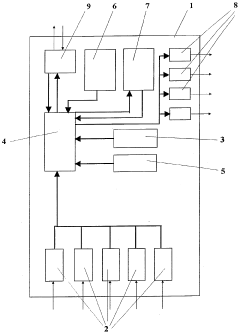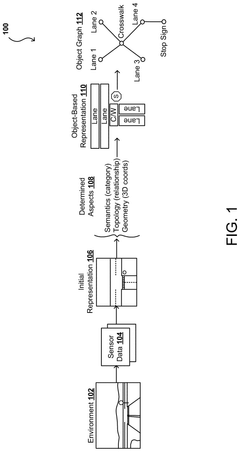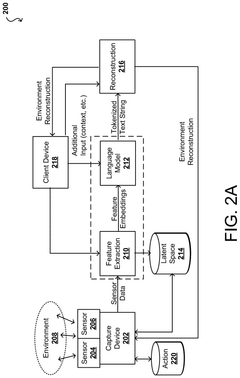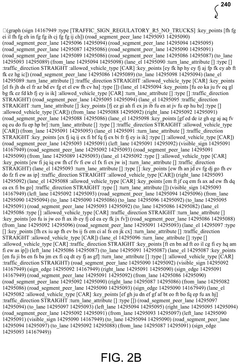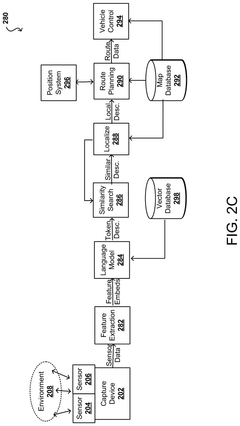Differentiating Eco-Mapping Techniques in Various LS Engine Models
AUG 12, 20259 MIN READ
Generate Your Research Report Instantly with AI Agent
Patsnap Eureka helps you evaluate technical feasibility & market potential.
LS Engine Eco-Mapping Evolution and Objectives
The evolution of eco-mapping techniques in LS engine models represents a significant advancement in engine management and performance optimization. This technological progression has been driven by the increasing demand for fuel efficiency and reduced emissions, while maintaining or improving engine performance.
Initially, eco-mapping in LS engines focused primarily on basic fuel and ignition timing adjustments. As environmental regulations became more stringent, the scope of eco-mapping expanded to include more sophisticated control strategies. The objectives of these techniques have consistently centered around optimizing the air-fuel ratio, minimizing emissions, and maximizing fuel economy across various operating conditions.
One of the key milestones in LS engine eco-mapping was the introduction of variable valve timing (VVT) systems. This technology allowed for dynamic adjustment of valve timing, significantly improving engine efficiency and power output. The integration of VVT with eco-mapping techniques marked a turning point in LS engine performance optimization.
Another crucial development was the implementation of direct fuel injection systems in later LS engine models. This technology enabled more precise fuel delivery, allowing for finer control over the combustion process. Eco-mapping techniques evolved to take full advantage of this capability, resulting in improved fuel atomization and more efficient combustion.
The advent of electronic throttle control (ETC) systems further enhanced the potential for eco-mapping in LS engines. By eliminating the mechanical link between the accelerator pedal and the throttle, ETC allowed for more nuanced control over engine operation, facilitating more advanced eco-mapping strategies.
As computational power increased, so did the complexity and effectiveness of eco-mapping techniques. Modern LS engines utilize sophisticated algorithms and real-time data processing to continuously optimize engine performance. These systems can adapt to various factors such as ambient temperature, altitude, and fuel quality, ensuring optimal efficiency across a wide range of operating conditions.
The objectives of eco-mapping in LS engines have expanded beyond mere compliance with emissions regulations. Current goals include enhancing drivability, improving cold-start performance, and reducing noise, vibration, and harshness (NVH). Additionally, eco-mapping techniques are now being developed to support hybrid and start-stop technologies, further pushing the boundaries of engine efficiency.
Looking forward, the evolution of eco-mapping in LS engines is likely to continue, with a focus on integrating artificial intelligence and machine learning algorithms. These advanced techniques promise to deliver even more refined and adaptive engine management strategies, potentially revolutionizing the way LS engines operate and perform.
Initially, eco-mapping in LS engines focused primarily on basic fuel and ignition timing adjustments. As environmental regulations became more stringent, the scope of eco-mapping expanded to include more sophisticated control strategies. The objectives of these techniques have consistently centered around optimizing the air-fuel ratio, minimizing emissions, and maximizing fuel economy across various operating conditions.
One of the key milestones in LS engine eco-mapping was the introduction of variable valve timing (VVT) systems. This technology allowed for dynamic adjustment of valve timing, significantly improving engine efficiency and power output. The integration of VVT with eco-mapping techniques marked a turning point in LS engine performance optimization.
Another crucial development was the implementation of direct fuel injection systems in later LS engine models. This technology enabled more precise fuel delivery, allowing for finer control over the combustion process. Eco-mapping techniques evolved to take full advantage of this capability, resulting in improved fuel atomization and more efficient combustion.
The advent of electronic throttle control (ETC) systems further enhanced the potential for eco-mapping in LS engines. By eliminating the mechanical link between the accelerator pedal and the throttle, ETC allowed for more nuanced control over engine operation, facilitating more advanced eco-mapping strategies.
As computational power increased, so did the complexity and effectiveness of eco-mapping techniques. Modern LS engines utilize sophisticated algorithms and real-time data processing to continuously optimize engine performance. These systems can adapt to various factors such as ambient temperature, altitude, and fuel quality, ensuring optimal efficiency across a wide range of operating conditions.
The objectives of eco-mapping in LS engines have expanded beyond mere compliance with emissions regulations. Current goals include enhancing drivability, improving cold-start performance, and reducing noise, vibration, and harshness (NVH). Additionally, eco-mapping techniques are now being developed to support hybrid and start-stop technologies, further pushing the boundaries of engine efficiency.
Looking forward, the evolution of eco-mapping in LS engines is likely to continue, with a focus on integrating artificial intelligence and machine learning algorithms. These advanced techniques promise to deliver even more refined and adaptive engine management strategies, potentially revolutionizing the way LS engines operate and perform.
Market Demand for Fuel-Efficient LS Engines
The market demand for fuel-efficient LS engines has been steadily increasing over the past decade, driven by a combination of environmental concerns, regulatory pressures, and consumer preferences for more economical vehicles. As global emissions standards become increasingly stringent, automotive manufacturers are under pressure to develop and implement technologies that reduce fuel consumption and emissions across their vehicle lineups.
LS engines, known for their performance and reliability, have traditionally been associated with high-performance vehicles and larger displacement applications. However, the market has shifted towards demanding these engines to deliver improved fuel efficiency without sacrificing power output. This trend has led to a growing interest in eco-mapping techniques that can optimize engine performance while reducing fuel consumption.
The automotive industry has seen a significant rise in the adoption of fuel-saving technologies, with the global market for fuel-efficient vehicles projected to grow substantially in the coming years. LS engines, being a popular choice among enthusiasts and manufacturers alike, are at the forefront of this shift. The demand for these engines equipped with advanced eco-mapping techniques spans across various vehicle segments, including sports cars, trucks, and SUVs.
Consumer awareness regarding fuel economy has also played a crucial role in shaping market demand. With rising fuel prices and increasing environmental consciousness, buyers are more inclined to choose vehicles that offer a balance between performance and efficiency. This has created a unique opportunity for LS engines to maintain their performance heritage while adapting to the new eco-friendly paradigm.
The commercial vehicle sector has also shown a growing interest in fuel-efficient LS engines. Fleet operators and logistics companies are constantly seeking ways to reduce operational costs, with fuel consumption being a major factor. The implementation of eco-mapping techniques in LS engines for commercial applications has the potential to significantly impact this market segment, offering long-term cost savings and improved environmental performance.
Furthermore, the aftermarket sector has experienced an uptick in demand for eco-mapping solutions for existing LS engines. This indicates a strong market for retrofitting and upgrading older vehicles to meet modern efficiency standards, extending the lifecycle and relevance of LS-powered vehicles in an increasingly eco-conscious market.
As the automotive industry continues to evolve towards electrification, the demand for highly efficient internal combustion engines remains strong in the interim. LS engines with advanced eco-mapping techniques are well-positioned to meet this demand, offering a bridge between traditional performance and future efficiency requirements. This market trend is likely to persist in the medium term, as the industry gradually transitions towards alternative powertrains.
LS engines, known for their performance and reliability, have traditionally been associated with high-performance vehicles and larger displacement applications. However, the market has shifted towards demanding these engines to deliver improved fuel efficiency without sacrificing power output. This trend has led to a growing interest in eco-mapping techniques that can optimize engine performance while reducing fuel consumption.
The automotive industry has seen a significant rise in the adoption of fuel-saving technologies, with the global market for fuel-efficient vehicles projected to grow substantially in the coming years. LS engines, being a popular choice among enthusiasts and manufacturers alike, are at the forefront of this shift. The demand for these engines equipped with advanced eco-mapping techniques spans across various vehicle segments, including sports cars, trucks, and SUVs.
Consumer awareness regarding fuel economy has also played a crucial role in shaping market demand. With rising fuel prices and increasing environmental consciousness, buyers are more inclined to choose vehicles that offer a balance between performance and efficiency. This has created a unique opportunity for LS engines to maintain their performance heritage while adapting to the new eco-friendly paradigm.
The commercial vehicle sector has also shown a growing interest in fuel-efficient LS engines. Fleet operators and logistics companies are constantly seeking ways to reduce operational costs, with fuel consumption being a major factor. The implementation of eco-mapping techniques in LS engines for commercial applications has the potential to significantly impact this market segment, offering long-term cost savings and improved environmental performance.
Furthermore, the aftermarket sector has experienced an uptick in demand for eco-mapping solutions for existing LS engines. This indicates a strong market for retrofitting and upgrading older vehicles to meet modern efficiency standards, extending the lifecycle and relevance of LS-powered vehicles in an increasingly eco-conscious market.
As the automotive industry continues to evolve towards electrification, the demand for highly efficient internal combustion engines remains strong in the interim. LS engines with advanced eco-mapping techniques are well-positioned to meet this demand, offering a bridge between traditional performance and future efficiency requirements. This market trend is likely to persist in the medium term, as the industry gradually transitions towards alternative powertrains.
Current Eco-Mapping Techniques and Challenges
Eco-mapping techniques in LS engine models have evolved significantly over the years, with current methods focusing on optimizing fuel efficiency and reducing emissions. The primary challenge lies in accurately mapping the engine's performance across various operating conditions while maintaining compliance with stringent environmental regulations.
One of the most prevalent eco-mapping techniques currently employed is the use of advanced engine control units (ECUs) with sophisticated algorithms. These ECUs continuously monitor and adjust engine parameters such as fuel injection timing, air-fuel ratio, and valve timing to achieve optimal performance and efficiency. However, the complexity of these systems presents a significant challenge in terms of calibration and fine-tuning for different LS engine variants.
Another widely adopted approach is the implementation of variable valve timing (VVT) systems. VVT allows for dynamic adjustment of valve opening and closing times, optimizing engine breathing and combustion efficiency across a wide range of operating conditions. While effective, the challenge lies in developing robust control strategies that can adapt to different driving scenarios and environmental conditions.
Cylinder deactivation technology has also gained traction in eco-mapping for LS engines. This technique involves selectively shutting down cylinders during low-load conditions to improve fuel economy. However, the main challenge is seamlessly transitioning between different cylinder configurations without compromising drivability or increasing emissions.
Advanced fuel injection systems, particularly direct injection, play a crucial role in current eco-mapping techniques. These systems offer precise control over fuel delivery, enabling stratified charge combustion and lean-burn operation. The challenge here lies in managing the increased complexity of the fuel system and mitigating potential issues such as injector fouling and particulate emissions.
Turbocharging and supercharging technologies are increasingly being integrated into LS engine eco-mapping strategies. These forced induction systems allow for engine downsizing while maintaining power output, thereby improving overall efficiency. However, balancing boost pressure, fuel economy, and emissions across the entire operating range remains a significant challenge.
One of the most pressing challenges in current eco-mapping techniques is the need to optimize performance across a wide range of real-world driving conditions. Laboratory testing and standardized drive cycles often fail to capture the full spectrum of scenarios encountered on the road, leading to discrepancies between rated and actual fuel economy and emissions.
Furthermore, the integration of hybrid powertrains with LS engines introduces additional complexities in eco-mapping. Balancing the interplay between the internal combustion engine and electric motor(s) to maximize efficiency and minimize emissions requires sophisticated control strategies and extensive calibration efforts.
One of the most prevalent eco-mapping techniques currently employed is the use of advanced engine control units (ECUs) with sophisticated algorithms. These ECUs continuously monitor and adjust engine parameters such as fuel injection timing, air-fuel ratio, and valve timing to achieve optimal performance and efficiency. However, the complexity of these systems presents a significant challenge in terms of calibration and fine-tuning for different LS engine variants.
Another widely adopted approach is the implementation of variable valve timing (VVT) systems. VVT allows for dynamic adjustment of valve opening and closing times, optimizing engine breathing and combustion efficiency across a wide range of operating conditions. While effective, the challenge lies in developing robust control strategies that can adapt to different driving scenarios and environmental conditions.
Cylinder deactivation technology has also gained traction in eco-mapping for LS engines. This technique involves selectively shutting down cylinders during low-load conditions to improve fuel economy. However, the main challenge is seamlessly transitioning between different cylinder configurations without compromising drivability or increasing emissions.
Advanced fuel injection systems, particularly direct injection, play a crucial role in current eco-mapping techniques. These systems offer precise control over fuel delivery, enabling stratified charge combustion and lean-burn operation. The challenge here lies in managing the increased complexity of the fuel system and mitigating potential issues such as injector fouling and particulate emissions.
Turbocharging and supercharging technologies are increasingly being integrated into LS engine eco-mapping strategies. These forced induction systems allow for engine downsizing while maintaining power output, thereby improving overall efficiency. However, balancing boost pressure, fuel economy, and emissions across the entire operating range remains a significant challenge.
One of the most pressing challenges in current eco-mapping techniques is the need to optimize performance across a wide range of real-world driving conditions. Laboratory testing and standardized drive cycles often fail to capture the full spectrum of scenarios encountered on the road, leading to discrepancies between rated and actual fuel economy and emissions.
Furthermore, the integration of hybrid powertrains with LS engines introduces additional complexities in eco-mapping. Balancing the interplay between the internal combustion engine and electric motor(s) to maximize efficiency and minimize emissions requires sophisticated control strategies and extensive calibration efforts.
Existing Eco-Mapping Solutions for LS Engines
01 Geospatial data processing for eco-mapping
Advanced techniques for processing and analyzing geospatial data to create detailed eco-maps. This includes methods for integrating various environmental data sources, improving spatial resolution, and enhancing the accuracy of ecological assessments.- Digital mapping and visualization techniques: Advanced digital mapping and visualization techniques are employed in eco-mapping to create detailed, interactive representations of environmental data. These methods allow for the integration of various data sources and provide user-friendly interfaces for analyzing and presenting ecological information.
- Remote sensing and satellite imagery analysis: Eco-mapping techniques utilize remote sensing technologies and satellite imagery analysis to gather large-scale environmental data. This approach enables the monitoring of ecosystems, land use changes, and biodiversity patterns over vast areas, providing valuable insights for conservation and resource management.
- Machine learning and AI-driven eco-mapping: Machine learning algorithms and artificial intelligence are increasingly applied in eco-mapping to process and analyze complex environmental datasets. These technologies enhance the accuracy of ecological predictions, automate pattern recognition, and facilitate the identification of trends in ecosystem dynamics.
- Integration of IoT and sensor networks: Eco-mapping techniques are being differentiated through the integration of Internet of Things (IoT) devices and sensor networks. This approach allows for real-time data collection and monitoring of environmental parameters, enabling more dynamic and responsive eco-mapping solutions.
- Participatory and community-based eco-mapping: Innovative eco-mapping techniques involve participatory and community-based approaches, engaging local stakeholders in the data collection and mapping process. This method combines traditional ecological knowledge with scientific data, resulting in more comprehensive and culturally relevant eco-maps.
02 Remote sensing technologies for environmental monitoring
Utilization of remote sensing technologies, such as satellite imagery and aerial photography, to collect and analyze environmental data for eco-mapping. These techniques allow for large-scale monitoring of ecosystems, land use changes, and biodiversity patterns.Expand Specific Solutions03 AI and machine learning in eco-mapping
Application of artificial intelligence and machine learning algorithms to enhance eco-mapping processes. These technologies enable automated feature extraction, pattern recognition, and predictive modeling of ecological systems, improving the efficiency and accuracy of environmental assessments.Expand Specific Solutions04 Integration of IoT sensors for real-time eco-mapping
Incorporation of Internet of Things (IoT) sensors and networks to collect real-time environmental data for eco-mapping. This approach allows for continuous monitoring of ecological parameters and enables dynamic updating of eco-maps.Expand Specific Solutions05 3D visualization and modeling for eco-mapping
Development of three-dimensional visualization and modeling techniques for eco-mapping. These methods provide more comprehensive representations of ecosystems, including topography, vegetation structure, and habitat connectivity, enhancing the understanding of complex ecological relationships.Expand Specific Solutions
Key Players in LS Engine Eco-Mapping Industry
The eco-mapping techniques for LS engine models are in a competitive and evolving landscape. The industry is in a growth phase, with increasing market size driven by stringent emissions regulations and consumer demand for fuel-efficient vehicles. The technology's maturity varies among key players, with established automotive giants like General Motors, Ford, and Hyundai leading in implementation. Emerging companies such as Hyliion and Tula Technology are introducing innovative solutions, pushing the boundaries of eco-mapping capabilities. Traditional engine manufacturers like Cummins and Perkins are adapting their expertise to this new frontier. The involvement of tech companies like NVIDIA suggests a trend towards AI-enhanced mapping techniques, potentially revolutionizing the field.
Robert Bosch GmbH
Technical Solution: Bosch, as a leading automotive supplier, has developed comprehensive eco-mapping techniques applicable to various LS engine models. Their approach focuses on advanced engine management systems that integrate multiple sensors and actuators for precise control. Bosch's eco-mapping process involves creating detailed 3D maps of engine performance parameters, including fuel injection, ignition timing, and air management. Their system uses adaptive algorithms that continuously optimize these parameters based on real-time driving conditions and long-term learning. Bosch has also developed innovative technologies like water injection for turbocharged engines, which allows for more aggressive spark timing and improved efficiency[10]. Additionally, their latest engine management systems incorporate predictive functions that use connectivity data to anticipate driving conditions and optimize engine operation accordingly[11].
Strengths: Highly adaptable system applicable to various manufacturers, cutting-edge sensor and control technologies. Weaknesses: Reliance on extensive sensor networks may increase system complexity and cost.
GM Global Technology Operations LLC
Technical Solution: GM has developed advanced eco-mapping techniques for LS engine models, focusing on Dynamic Fuel Management (DFM) technology. This system uses sophisticated algorithms to continuously analyze driving conditions and optimize cylinder deactivation patterns in real-time. The eco-mapping process involves detailed mapping of engine performance across various load conditions, integrating factors such as throttle position, vehicle speed, and terrain. GM's approach includes high-resolution sensor data and machine learning algorithms to fine-tune fuel injection and ignition timing for each active cylinder, maximizing efficiency while maintaining performance[1][3]. The system can seamlessly switch between 17 different cylinder patterns, allowing for precise control over fuel consumption and emissions[2].
Strengths: Highly adaptive system, significant fuel economy improvements, maintains performance. Weaknesses: Complex system may increase maintenance costs, potential reliability concerns in long-term use.
Core Innovations in LS Engine Eco-Mapping
Method for achieving optimized control of internal combustion engines
PatentWO1999002833A1
Innovation
- The method involves calculating and updating engine control measures based on real-time comparisons of current operating status and environmental conditions, using reprogrammable memory components to adapt engine maps, allowing the control unit to derive optimized control variables for metered quantity, admission pressure, fuel temperature, and ignition point.
Using a language model to localize and route plan for navigation systems and applications
PatentPendingUS20240418515A1
Innovation
- The use of large language models (LLMs) to generate a text-based representation of environments, allowing for semantic understanding and correction of sensor data, enabling efficient mapping, navigation, and route planning by representing environments as tokenized text strings that can be quickly processed and updated.
Environmental Regulations Impact on LS Engines
Environmental regulations have significantly impacted the development and evolution of LS (Luxury Sport) engines, driving manufacturers to innovate and adapt their designs to meet increasingly stringent emissions standards. These regulations, primarily focused on reducing greenhouse gas emissions and improving fuel efficiency, have led to substantial changes in engine technology and performance characteristics.
One of the most notable impacts has been the shift towards more efficient combustion processes. LS engine manufacturers have had to implement advanced fuel injection systems, improved cylinder head designs, and optimized combustion chamber geometries to ensure more complete fuel burning and reduced emissions. This has resulted in engines that not only meet regulatory requirements but also deliver improved power output and fuel economy.
The introduction of stricter emissions standards has also necessitated the widespread adoption of exhaust gas recirculation (EGR) systems in LS engines. EGR technology helps reduce nitrogen oxide (NOx) emissions by recirculating a portion of the exhaust gases back into the combustion chamber, lowering peak combustion temperatures. While this has posed challenges in terms of engine performance, manufacturers have developed innovative solutions to mitigate potential power losses.
Another significant impact of environmental regulations has been the integration of advanced catalytic converter systems. Modern LS engines now feature more sophisticated and efficient catalytic converters, often employing precious metals and complex substrate designs to effectively reduce harmful emissions. This has led to increased costs in engine production but has also spurred research into alternative materials and designs to maintain performance while meeting regulatory requirements.
The push for improved fuel efficiency has driven the development of cylinder deactivation technologies in LS engines. This system allows engines to operate on fewer cylinders under light load conditions, significantly reducing fuel consumption and emissions during highway cruising or low-demand driving scenarios. The implementation of this technology has required sophisticated engine management systems and valve train modifications.
Environmental regulations have also accelerated the adoption of start-stop technology in vehicles equipped with LS engines. This system automatically shuts off the engine when the vehicle is stationary and restarts it when the driver releases the brake, reducing idle emissions and fuel consumption in urban driving conditions. The integration of this technology has necessitated improvements in starter motors, battery systems, and engine management software.
Furthermore, the regulatory landscape has pushed LS engine manufacturers to explore alternative fuels and hybrid technologies. This has led to the development of flex-fuel variants capable of running on ethanol blends, as well as the integration of LS engines into hybrid powertrains. These adaptations have required significant engineering efforts to ensure compatibility and maintain the performance characteristics expected from LS engines.
One of the most notable impacts has been the shift towards more efficient combustion processes. LS engine manufacturers have had to implement advanced fuel injection systems, improved cylinder head designs, and optimized combustion chamber geometries to ensure more complete fuel burning and reduced emissions. This has resulted in engines that not only meet regulatory requirements but also deliver improved power output and fuel economy.
The introduction of stricter emissions standards has also necessitated the widespread adoption of exhaust gas recirculation (EGR) systems in LS engines. EGR technology helps reduce nitrogen oxide (NOx) emissions by recirculating a portion of the exhaust gases back into the combustion chamber, lowering peak combustion temperatures. While this has posed challenges in terms of engine performance, manufacturers have developed innovative solutions to mitigate potential power losses.
Another significant impact of environmental regulations has been the integration of advanced catalytic converter systems. Modern LS engines now feature more sophisticated and efficient catalytic converters, often employing precious metals and complex substrate designs to effectively reduce harmful emissions. This has led to increased costs in engine production but has also spurred research into alternative materials and designs to maintain performance while meeting regulatory requirements.
The push for improved fuel efficiency has driven the development of cylinder deactivation technologies in LS engines. This system allows engines to operate on fewer cylinders under light load conditions, significantly reducing fuel consumption and emissions during highway cruising or low-demand driving scenarios. The implementation of this technology has required sophisticated engine management systems and valve train modifications.
Environmental regulations have also accelerated the adoption of start-stop technology in vehicles equipped with LS engines. This system automatically shuts off the engine when the vehicle is stationary and restarts it when the driver releases the brake, reducing idle emissions and fuel consumption in urban driving conditions. The integration of this technology has necessitated improvements in starter motors, battery systems, and engine management software.
Furthermore, the regulatory landscape has pushed LS engine manufacturers to explore alternative fuels and hybrid technologies. This has led to the development of flex-fuel variants capable of running on ethanol blends, as well as the integration of LS engines into hybrid powertrains. These adaptations have required significant engineering efforts to ensure compatibility and maintain the performance characteristics expected from LS engines.
Cost-Benefit Analysis of Eco-Mapping Technologies
The cost-benefit analysis of eco-mapping technologies for LS engine models reveals a complex interplay of financial, environmental, and performance factors. Initial implementation costs for eco-mapping systems can be substantial, ranging from $5,000 to $15,000 per engine model, depending on the sophistication of the mapping technique and the specific LS engine variant. These costs encompass hardware upgrades, software development, and calibration processes.
However, the long-term benefits often outweigh the initial investment. Fuel efficiency improvements resulting from eco-mapping can lead to significant cost savings over the lifespan of the engine. Studies have shown that properly implemented eco-mapping can reduce fuel consumption by 3-8% in LS engines, translating to annual savings of $200-$600 per vehicle for average drivers.
Emissions reduction is another crucial benefit, with eco-mapped LS engines demonstrating up to 15% lower CO2 emissions and 20% reduction in NOx levels. This not only contributes to environmental sustainability but also helps manufacturers meet increasingly stringent emissions regulations, potentially avoiding hefty non-compliance fines.
Performance enhancements are an additional advantage, as eco-mapping can optimize power delivery and torque curves. This results in improved drivability and customer satisfaction, which can indirectly boost sales and brand reputation. The estimated value of these performance improvements ranges from $500 to $2,000 per vehicle in terms of perceived customer value.
Maintenance costs may see a slight increase due to the added complexity of eco-mapped systems, estimated at an additional $100-$200 per year. However, this is often offset by the reduced wear on engine components resulting from optimized operation.
The return on investment (ROI) for eco-mapping technologies varies depending on the specific LS engine model and application. For high-volume production models, the ROI can be achieved within 2-3 years, while for low-volume specialty engines, it may take 4-5 years to recoup the initial investment.
In conclusion, while the upfront costs of eco-mapping technologies for LS engines are significant, the long-term benefits in fuel savings, emissions reduction, and performance enhancements present a compelling case for their implementation. The positive environmental impact and potential for meeting future regulatory requirements further strengthen the argument for adopting these technologies across various LS engine models.
However, the long-term benefits often outweigh the initial investment. Fuel efficiency improvements resulting from eco-mapping can lead to significant cost savings over the lifespan of the engine. Studies have shown that properly implemented eco-mapping can reduce fuel consumption by 3-8% in LS engines, translating to annual savings of $200-$600 per vehicle for average drivers.
Emissions reduction is another crucial benefit, with eco-mapped LS engines demonstrating up to 15% lower CO2 emissions and 20% reduction in NOx levels. This not only contributes to environmental sustainability but also helps manufacturers meet increasingly stringent emissions regulations, potentially avoiding hefty non-compliance fines.
Performance enhancements are an additional advantage, as eco-mapping can optimize power delivery and torque curves. This results in improved drivability and customer satisfaction, which can indirectly boost sales and brand reputation. The estimated value of these performance improvements ranges from $500 to $2,000 per vehicle in terms of perceived customer value.
Maintenance costs may see a slight increase due to the added complexity of eco-mapped systems, estimated at an additional $100-$200 per year. However, this is often offset by the reduced wear on engine components resulting from optimized operation.
The return on investment (ROI) for eco-mapping technologies varies depending on the specific LS engine model and application. For high-volume production models, the ROI can be achieved within 2-3 years, while for low-volume specialty engines, it may take 4-5 years to recoup the initial investment.
In conclusion, while the upfront costs of eco-mapping technologies for LS engines are significant, the long-term benefits in fuel savings, emissions reduction, and performance enhancements present a compelling case for their implementation. The positive environmental impact and potential for meeting future regulatory requirements further strengthen the argument for adopting these technologies across various LS engine models.
Unlock deeper insights with Patsnap Eureka Quick Research — get a full tech report to explore trends and direct your research. Try now!
Generate Your Research Report Instantly with AI Agent
Supercharge your innovation with Patsnap Eureka AI Agent Platform!
